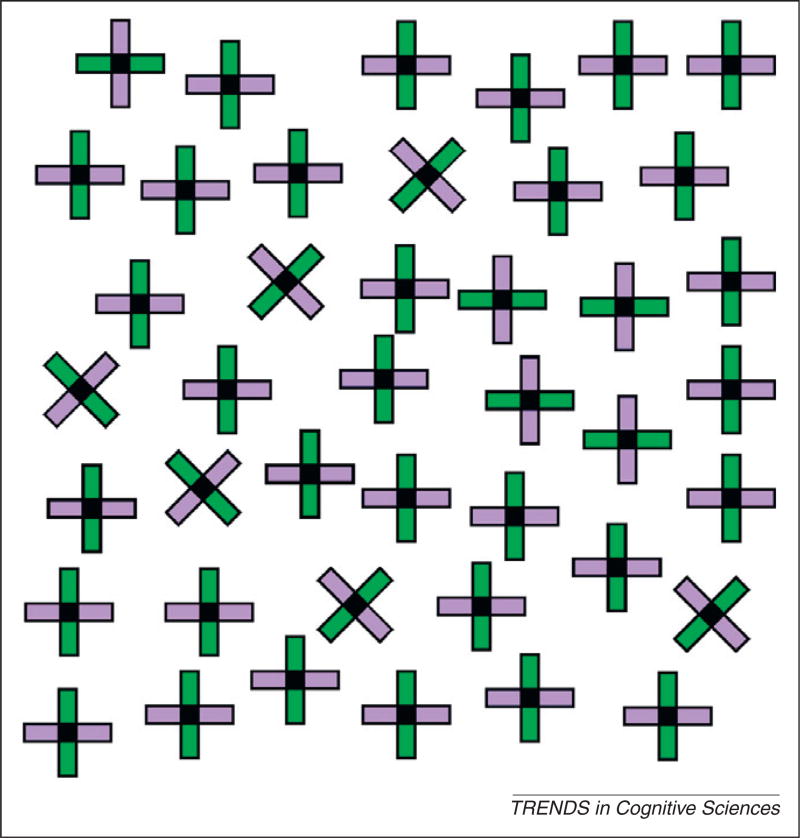In his opinion article [1], Vincent Di Lollo argues that the binding problem [2–4] is ‘ill-posed’. I disagree. The binding problem is, in fact, a very real problem, solved in the visual system with the aid of selective attention. What was ‘ill-posed’, or just incorrect, was the traditional mapping of the problem onto the brain.
The binding problem could be described as the problem of knowing how basic features relate to each other. Thus, in Figure 1, it is perfectly clear, once you attend to the upper left-hand item, that it consists of vertical purple and green horizontal regions. Without directing your attention, you can see that the rest of the image contains similar items and you can easily discern that some of those items are rotated 45 degrees. However, you will have no idea if items possess green vertical or horizontal regions unless you attend to them. That is the binding problem. It has not gone away. (Of course, this is a demonstration figure. It may suffer from ‘crowding’ issues [5], as well as binding problems. However, in the laboratory, the same point can be made with very small numbers of widely spaced items [6]).
Figure 1.
In this figure, it is immediately obvious that there are green and purple ‘plusses’, some of the rotated to form ‘X’s. However, it will require attention and binding to determine if a given plus has green vertical or green horizontal components.
Di Lollo challenges an early neurophysiological account of binding, which held that features such as color and orientation were processed in geographically separate pieces of cortex and, thus separated, the features needed to be ‘bound’ together in order to see coherent objects. He argues that this old ‘feature module’ idea was over-stated: cells tend to be tuned for multiple features and, therefore, binding is not necessary.
This throws the binding baby out with the physiological bathwater – illustrating, as it does so, the perils of considering neuroscience to be the arbiter of the value of psychological/cognitive models. In fact, it does not make the slightest difference to the reality of the binding problem if color and orientation are handled in separate ‘modules’ or in the same piece of brain. The fact remains that, whatever your cells may be doing, you, as the user of those cells, cannot distinguish green vertical plusses from green horizontal ones until you selectively attend to one item.
The ‘problem’ in the binding problem is not geography; it is capacity. The problem is that the nervous system is limited in the number of objects it can recognize at the same time. The limit may be one object or very few but, as you look at the world in front of you, the collections of features do not form themselves into recognized objects until some collection of features, forming something like a ‘proto-object’ [7], is selected by attention. At that point, the features can be said to be bound into a recognizable item.
You seem to be able to perceive some aspects of the figure without selective attention. You know, for instance, that these are green and purple plusses. Similarly, it is possible, in the absence of binding, to make some successful decisions in laboratory tasks. These can be quite complex, such as identifying the presence of an animal [8], and may reflect the power of feed-forward processing [9]. Beyond that, however, Di Lollo is probably correct to invoke ‘iterative reentrant processing’. If this processing consists of cycles of feedback from higher cortical processes reaching back to make contact with visual information in earlier areas, that sounds a great deal like what might be proposed in 2012 as the physiological substrate of selective attention. Like earlier notions of geographically distinct maps for every feature, this mapping of physiology onto behavior might be incorrect. Eventually, we may learn how the brain implements behavior. While we wait, visual processing will remain capacity limited. In the absence of attention, we will know rather little about how basic features are tied to their objects, and the binding problem will remain well-posed.
References
- 1.Di Lollo V. The feature-binding problem is an ill-posed problem. Trends Cogn. Sci. 2012;16:317–321. doi: 10.1016/j.tics.2012.04.007. [DOI] [PubMed] [Google Scholar]
- 2.Malsburg, von der C. The correlation theory of brain function. In: Domany JL, et al., editors. Models of Neural Networks II: Temporal Aspects of Coding and Information Processing in Biological Systems. Springer-Verlag; 1981. pp. 95–119. (reprinted in 1994) [Google Scholar]
- 3.Treisman A. The binding problem. Curr. Opin. Neurobiol. 1996;6:171–178. doi: 10.1016/s0959-4388(96)80070-5. [DOI] [PubMed] [Google Scholar]
- 4.Wolfe JM, Cave KR. The psychophysical evidence for a binding problem in human vision. Neuron. 1999;24:11–17. doi: 10.1016/s0896-6273(00)80818-1. [DOI] [PubMed] [Google Scholar]
- 5.Rosenholtz R, et al. A summary statistic representation in peripheral vision explains. J. Vis. 2012;12 doi: 10.1167/9.12.13. article 14. [DOI] [PMC free article] [PubMed] [Google Scholar]
- 6.Wolfe JM, Bennett SC. Preattentive object files: shapeless bundles of basic features. Vis. Res. 1997;37:25–43. doi: 10.1016/s0042-6989(96)00111-3. [DOI] [PubMed] [Google Scholar]
- 7.Rensink RA. Seeing, sensing, and scrutinizing. Vis. Res. 2000;40:1469–1487. doi: 10.1016/s0042-6989(00)00003-1. [DOI] [PubMed] [Google Scholar]
- 8.Li FF, et al. Rapid natural scene categorization in the near absence of attention. Proc. Natl. Acad. Sci. U.S.A. 2002;99:9596–9601. doi: 10.1073/pnas.092277599. [DOI] [PMC free article] [PubMed] [Google Scholar]
- 9.Serre T, et al. A feedforward architecture accounts for rapid categorization. Proc. Natl. Acad. Sci. U.S.A. 2007;104:6424–6429. doi: 10.1073/pnas.0700622104. [DOI] [PMC free article] [PubMed] [Google Scholar]



